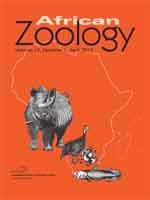The Lufubu River is the largest tributary to the southern Lake Tanganyika and its upper reaches are separated from the lake by rapids that prevent upstream movement of lacustrine fish. Thus, the ichthyofauna of the upper Lufubu River is clearly distinct from Lake Tanganyika and shows more similarities to the upper Congo and Zambezi systems. The phylogenetic relationships of three haplochromine cichlid species from the upper Lufubu River were analysed in the context of the phylogeographic structure of haplochromine cichlids from the surrounding hydrological systems. Patterns of genetic distances between the Lufubu fish and their sister taxa from the upper Congo system indicate that the headwaters of the Lufubu River were colonized from drainages pertaining to the Upper Congo system during extreme flooding or river capture events (at least several 100 000 years ago), possibly even three times independently. This study exemplifies how phylogeographic data from an understudied region might help to unravel unrecognized historical connections between separate water bodies and drainage systems in a geologically/hydrologically unstable region.
How to translate text using browser tools
1 April 2012
Past Connection of the Upper Reaches of a Lake Tanganyika Tributary with the Upper Congo Drainage Suggested by Genetic Data of Riverine Cichlid Fishes
S. Koblmüller,
C. Katongo,
H. Phiri,
C. Sturmbauer
ACCESS THE FULL ARTICLE

African Zoology
Vol. 47 • No. 1
April 2012
Vol. 47 • No. 1
April 2012
PHYLOGEOGRAPHY
Pseudocrenilabrus
river capture
Serranochromis
Zambia




